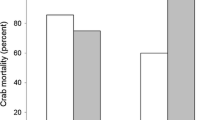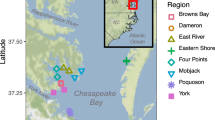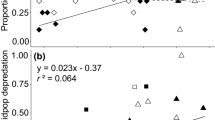Abstract
Habitat fragmentation is a process involving splitting of continuous habitats into smaller, and more isolated habitat patches. To assess the effects of small-scale habitat patchiness and isolation without the confounding effect of habitat loss on benthic macrofauna, two field experiments were conducted in the Archipelago Sea, SW Finland. Using artificial seagrass units (ASUs) we contrasted continuous patches (“C”) with fragmented patches (“F”) of the same combined area as the continuous patches. The fragmentation treatment involved two isolation distances (0.5 and 3.0 m) between the ASUs (“F 0.5”) and (“F 3.0”). This design was repeated in two consecutive experiments where the patch area was 0.25 and 0.0625 m2, respectively. Mobile epifauna were allowed to colonize patches for 12 days in both experiments. In both experiments, the total epifaunal density was significantly higher in the “F 0.5” treatment than in the “C” treatment, and the three dominant taxa showed positive or neutral responses to the habitat configuration. No fragmentation effect on the number of species was detected in either of the experiments, but fragmentation had a negative effect on the epifaunal diversity (Shannon’s H′) in the experiment with the largest patch area. Epifaunal diversity was significantly lower in “F 3.0” treatment than in “C” or “F 0.5” treatments in the first experiment, indicating stronger effect of isolation instead of fragmentation per se. Edge effects were indirectly tested by comparing epifaunal densities with patch edge:area ratios. The results suggest that edge effects may have a more important role than patch size for the total densities of epifaunal taxa, and that small, isolated patches have equal or higher habitat value compared to larger fragments.



Similar content being viewed by others
References
Andrén, H., 1994. Effects of habitat fragmentation on birds and mammals in landscapes with different proportions of suitable habitat: a review. Oikos 71: 355–366.
Attrill, M. J., J. A. Strong & A. A. Rowden, 2000. Are macroinvertebrate communities influenced by seagrass structural complexity? Ecography 23: 114–121.
Bell, J. D., M. Westoby & A. S. Steffe, 1987. Fish larvae settling in seagrass: do they discriminate between beds of different leaf density? Journal of Experimental Marine Biology and Ecology 111: 133–144.
Bell, S. S., R. A. Brooks, B. D. Robbins, M. S. Fonseca & M. O. Hall, 2001. Faunal response to fragmentation in seagrass habitats: implications for seagrass conservation. Biological Conservation 100: 115–123.
Bender, D. J., T. A. Contreras & L. Fahrig, 1998. Habitat loss and population decline: a meta-analysis of the patch size effect. Ecology 79: 517–533.
Bologna, P. A. X. & K. L. Heck, 2000. Impacts of seagrass habitat architecture on bivalve settlement. Estuaries and Coasts 23: 449–457.
Bologna, P. A. X. & K. L. Heck, 2002. Impact of habitat edges on density and secondary production of seagrass-associated fauna. Estuaries 25: 1033–1044.
Boström, C. & J. Mattila, 1999. The relative importance of food and shelter for seagrass associated invertebrates—a latitudinal comparison of habitat choice by isopod grazers. Oecologia 120: 162–170.
Boström, C., S. P. Baden & D. Krause-Jensen, 2003. The seagrasses of Scandinavia and the Baltic Sea. In Green, E. P., et al. (eds), World Atlas of Seagrasses: Present Status and Future Conservation. California Press, Berkley: 27–37.
Boström, C., E. L. Jackson & C. A. Simenstad, 2006. Seagrass landscapes and their effects on associated fauna: a review. Estuarine, Coastal and Shelf Science 68: 383–403.
Boström, C., A. Törnroos & E. Bonsdorff, 2010. Invertebrate dispersal and habitat heterogeneity: expression of biological traits in a seagrass landscape. Journal of Experimental Marine Biology and Ecology 390: 106–117.
Bowden, D. A., A. A. Rowden & M. J. Attrill, 2001. Effect of patch size and in-patch location on the infaunal macroinvertebrate assemblages of Zostera marina seagrass beds. Journal of Experimental Marine Biology and Ecology 259: 133–154.
Brooks, R. A. & S. S. Bell, 2001. Mobile corridors in marine landscapes: enhancement of faunal exchange at seagrass/sand ecotones. Journal of Experimental Marine Biology and Ecology 264: 67–84.
Connolly, R. D. & J. S. Hindell, 2006. Review of nekton patterns and ecological processes in seagrass landscapes. Estuarine, Coastal and Shelf Science 68: 433–444.
Duarte, C. M., 2002. The future of seagrass meadows. Environmental Conservation 29: 192–206.
Dunn, O. J., 1961. Multiple comparisons among means. Journal of American Statistical Association 56: 52–64.
Eggleston, D. B., L. L. Etherington & W. E. Elis, 1998. Organism response to habitat patchiness: species and habitat-dependent recruitment of decapod crustaceans. Journal of Experimental Marine Biology and Ecology 223: 111–132.
Eggleston, D. B., E. E. Ward, L. L. Etherington, C. P. Dahlgren & M. H. Posey, 1999. Organism responses to habitat fragmentation and diversity: habitat colonization by estuarine macrofauna. Journal of Experimental Marine Biology and Ecology 236: 107–132.
Fahrig, L., 2003. Effects of habitat fragmentation on biodiversity. Annual Review of Ecology, Evolution and Systematics 34: 487–515.
Fletcher, R. J., Jr., L. Ries, J. Battin & A. D. Chalfoun, 2007. The role of habitat area and edge in fragmented landscapes; definitely distinct or inevitably intertwined? Canadian Journal of Zoology 85: 1017–1030.
Freemark, K. E., J. B. Dunning, S. J. Hejl & J. R. Probst, 1995. A landscape ecology perspective for research, conservation and management. In Martin, T. E. & D. M. Finch (eds), Ecology and Management of Neotropical Migratory Birds. Oxford University Press, New York: 381–427.
Frost, M. T., A. A. Rowden & M. J. Attrill, 1999. Effects of habitat fragmentation on the macroinvertebrate infaunal communities associated with the seagrass Zostera marina L. Aquatic Conservation: Marine and Freshwater Ecosystems 9: 255–263.
Gascon, C. & T. E. Lovejoy, 1998. Ecological impacts of forest fragmentation in Central Amazonia. Zoology 101: 273–280.
Goodsell, P. J. & S. D. Connell, 2002. Can habitat loss be treated independently of habitat configuration? Implications for rare and common taxa in fragmented landscapes. Marine Ecology Progress Series 239: 37–44.
Goodsell, P. J., M. G. Chapman & A. J. Underwood, 2007. Differences between biota in anthropogenically fragmented habitats and in naturally patchy habitats. Marine Ecology Progress Series 351: 15–23.
Hanski, I. & M. E. Gilpin, 1997. Metapopulation Biology: Ecology, Genetics and Evolution. Academic Press, San Diego.
Harrison, S. & E. Bruna, 1999. Habitat fragmentation and large-scale conservation: what do we know for sure? Ecography 22: 225–232.
Hastings, K., P. Hesp & G. A. Kendrick, 1995. Seagrass loss associated with boat moorings at Rottnest Island, Western Australia. Ocean & Coastal Management 26: 225–246.
Healey, D. & K. A. Hovel, 2004. Seagrass bed patchiness: effects on epifaunal communities in San Diego Bay, USA. Journal of Experimental Marine Biology and Ecology 313: 155–174.
Heck, K. L., G. Hays & R. J. Orth, 2003. Critical evaluation of the nursery role hypothesis for seagrass meadows. Marine Ecology Progress Series 253: 123–136.
Hirst, J. A. & M. J. Attrill, 2008. Small is beautiful: an inverted view of habitat fragmentation in seagrass beds. Estuarine, Coastal and Shelf Science 78: 811–818.
Holmquist, J. G., 1994. Benthic macroalgae as a dispersal mechanism for fauna: influence of a marine tumbleweed. Journal of Experimental Marine Biology and Ecology 180: 235–251.
Hovel, K. A., 2003. Habitat fragmentation in marine landscapes: relative effects of habitat cover and configuration on juvenile crab survival in California and North Carolina seagrass beds. Biological Conservation 110: 401–412.
Hovel, K. A. & R. N. Lipcius, 2001. Habitat fragmentaton in a seagrass landscape: patch size and complexity control blue crab survival. Ecology 82: 1814–1829.
Hovel, K. A. & R. N. Lipcius, 2002. Effects of seagrass habitat fragmentation on juvenile blue crab survival and abundance. Journal of Experimental Marine Biology and Ecology 271: 75–98.
Irlandi, E. A., 1994. Large- and small-scale effects of habitat structure on rates of predation: how percent coverage of seagrass affects rates of predation and siphon nipping on an infaunal bivalve. Oecologia 98: 176–183.
Irlandi, E. A., 1997. Seagrass patch size and survivorship of an infaunal bivalve. Oikos 78: 511–518.
Irlandi, E. A., W. G. Ambrose & B. A. Orlando, 1995. Landscape ecology and the marine environment: how spatial configuration of seagrass habitat influences growth and survival of the bay scallop. Oikos 72: 307–313.
Jackson, E. L., A. S. Rowden, M. J. Attrill, S. Bossey & S. M. Jones, 2001. The importance of seagrass beds as a habitat for fishery species. Oceanography and Marine Biology 39: 269–303.
Johnson, A. R., J. A. Wiens, B. T. Milne & T. O. Crist, 1992. Animal movements and population dynamics in heterogenous landscapes. Landscape Ecology 7: 63–75.
Kolasa, J., 1989. Ecological systems in hierarchical perspective: breaks in community structure and other consequences. Ecology 70: 36–47.
Laurance, W. F., 2008. Review. Theory meets reality: how habitat fragmentation research has transcended island biogeographic theory. Biological Conservation 141: 1731–1744.
Loneragan, N. R., R. A. Kenyon, D. J. Staples, I. R. Poiner & C. A. Conacher, 1998. The influence of seagrass type on the distribution and abundance of postlarval and juvenile tiger prawns (Penaeus esculentus and P. semisulcatus) in the western Gulf of Carpentaria, Australia. Journal of Experimental Marine Biology and Ecology 228: 175–195.
McCoy, E. D. & S. S. Bell, 1991. Habitat structure: The evolution and diversification of a complex topic. Population and Community Biology Series: 3–27.
Macreadie, P. I., J. S. Hindell, G. P. Jenkins, R. M. Connolly & M. J. Keough, 2009. Fish responses to experimental fragmentation of seagrass habitat. Conservation Biology 23: 644–652.
McNeill, S. E. & P. G. Fairweather, 1993. Single large or several small marine reserves? An experiment approach with seagrass fauna. Journal of Biogeography 20: 429–440.
Montefalcone, M., V. Parravicini, M. Vacchi, G. Albertelli, M. Ferrari, C. Morri & C. N. Bianchi, 2010. Human influence on seagrass habitat fragmentation in NW Mediterranean Sea. Estuarine, Coastal and Shelf Science 86: 292–298.
Norkko, J., E. Bonsdorff & A. Norkko, 2000. Drifting algal mats as an alternative habitat for benthic invertebrates: species specific responses to a transient resource. Journal of Experimental Marine Biology and Ecology 248: 79–104.
Orth, R. J., T. J. B. Carruthers, W. C. Dennison, C. M. Duarte, J. F. Fourqurean, K. L. Heck, A. R. Hughes, G. A. Kendrick, W. J. Kenworthy, S. Olyarnik, F. T. Short, M. Waycott & S. L. Williams, 2006. A global crisis for seagrass ecosystems. Bioscience 56: 987–996.
Paine, R. & S. Levin, 1981. Intertidal landscapes; disturbances and dynamics of pattern. Ecological Monographs 51: 145–178.
Quinn, J. F. & S. P. Harrison, 1988. Effects of habitat fragmentation and isolation on species richness: evidence from biogeographic patterns. Oecologia 75: 132–140.
Reed, B. J. & K. A. Hovel, 2006. Seagrass habitat disturbance: how loss and fragmentation of eelgrass Zostera marina influences epifaunal abundance and diversity. Marine Ecology Progress Series 326: 133–143.
Ries, L., R. J. Fletcher Jr., J. Battin & T. D. Sisk, 2004. Ecological responses to habitat edges: mechanisms, models, and variability explained. Annual Review of Ecology, Evolution and Systematics 35: 491–522.
Robbins, B. D. & S. S. Bell, 1994. Seagrass landscapes: a terrestrial approach to the marine subtidal environment. Trends in Ecology and Evolution 9: 301–304.
Russell, B. D., B. M. Gillanders & S. D. Connell, 2005. Proximity and size of neighbouring habitat affects invertebrate diversity. Marine Ecology Progress Series 296: 31–38.
Salovius, S., M. Nyqvist & E. Bonsdorff, 2005. Life in the fast line: macrobenthos use temporary drifting algal habitats. Journal of Sea Research 53: 169–180.
Saunders, D., R. Hobbs & C. Margules, 1991. Biological consequences of ecosystem fragmentation: a review. Conservation Biology 5: 18–32.
Schooley, R. L. & J. A. Wiens, 2003. Finding habitat patches and directional connectivity. Oikos 102: 559–570.
Sogard, S. M., 1989. Colonization of artificial seagrass by fishes and decapod crustaceans: importance of proximity to natural eelgrass. Journal of Experimental Marine Biology and Ecology 133: 15–37.
Tanner, J. E., 2005. Edge effects on fauna in fragmented seagrass meadows. Austral Ecology 30: 210–218.
Taylor, P. D., L. Fahrig, G. Merriam & K. Henein, 1993. Connectivity is a vital element of landscape structure. Oikos 68: 571–573.
Uhrin, A. V. & J. G. Holmquist, 2003. Effects of propeller scarring on macrofaunal use of the seagrass Thalassia testudinum. Marine Ecology Progress Series 250: 61–70.
Underwood, A. J., 1997. Experiments in Ecology. Their Logical Design and Interpretation Using Analysis of Variance. Cambridge University Press, Cambridge.
Vacchi, M., M. Montefalcone, C. N. Bianchi, C. Morri & M. Ferrari, 2010. The influence of coastal dynamics on the upper limit of the Posidonia oceanica meadow. Marine Ecology 31: 546–554.
Virnstein, R. & M. Curran, 1986. Colonization of artificial seagrass versus time and distance from source. Marine Ecology Progress Series 29: 279–288.
Warry, F. Y., J. S. Hindell, P. I. Macreadie, G. P. Jenkins & R. M. Connolly, 2009. Integrating edge effects into studies of habitat fragmentation: a test using meiofauna in seagrass. Oecologia 159: 883–892.
Waycott, M., C. M. Duarte, T. J. B. Carruthers, R. J. Orth, W. C. Dennison, S. Olyarnik, A. Calladine, J. W. Fourqurean, K. L. Heck Jr., R. A. Hughes, G. A. Kendrick, W. J. Kenworthy, F. T. Short & S. L. Williams, 2009. Accelerating loss of seagrasses across the globe threatens coastal ecosystems. Proceedings of the National Academy of Sciences, USA 106: 12377–12381.
Wiens, J. A. & B. T. Milne, 1989. Scaling of ‘landscapes’ in landscape ecology, or, landscape ecology from a beetle’s perspective. Landscape Ecology 3: 87–96.
Acknowledgments
The authors express their gratitude to the elementary-school pupils, research assistants, and inexhaustible friends who helped with the construction of the ASUs. Anna Törnroos is acknowledged for field assistance. Patrik Kraufvelin is acknowledged for statistical advice. Two anonymous reviewers are acknowledged for improving an earlier draft of the manuscript. This experiment was funded by the Maj and Tor Nessling Foundation (Project 2006124).
Author information
Authors and Affiliations
Corresponding author
Additional information
Handling editor: Luis Mauricio Bini
Rights and permissions
About this article
Cite this article
Arponen, H., Boström, C. Responses of mobile epifauna to small-scale seagrass patchiness: is fragmentation important?. Hydrobiologia 680, 1–10 (2012). https://doi.org/10.1007/s10750-011-0895-x
Received:
Revised:
Accepted:
Published:
Issue Date:
DOI: https://doi.org/10.1007/s10750-011-0895-x




